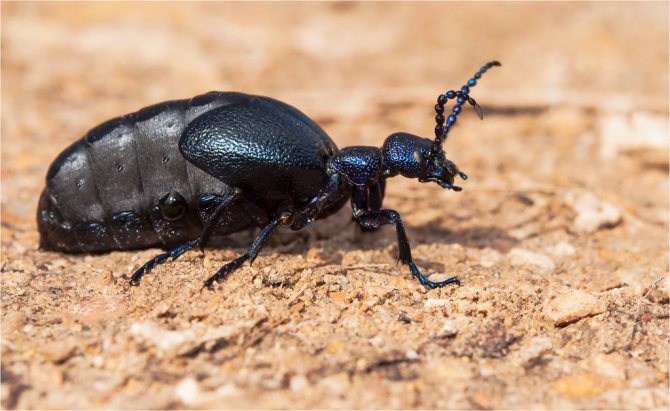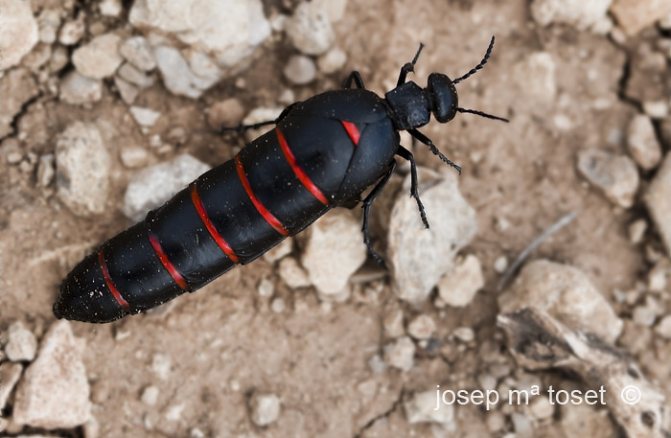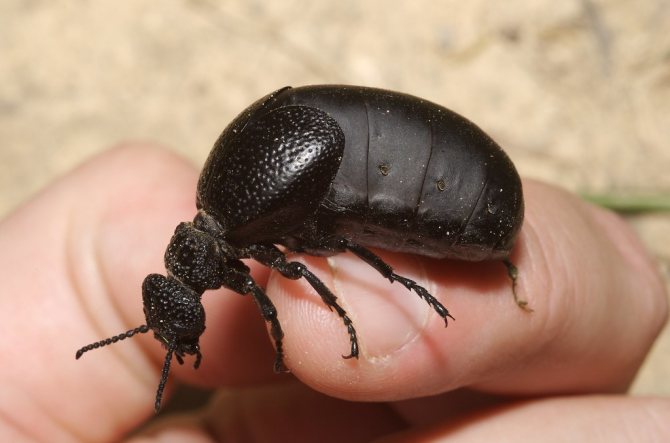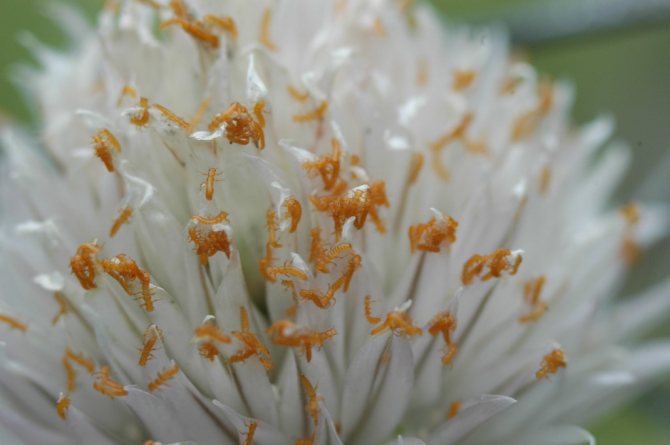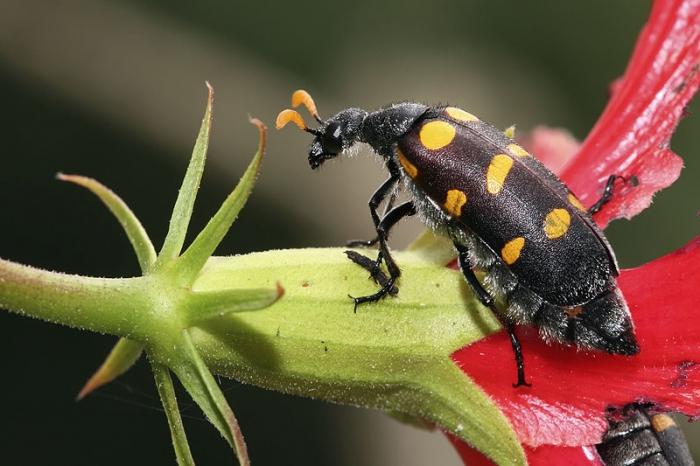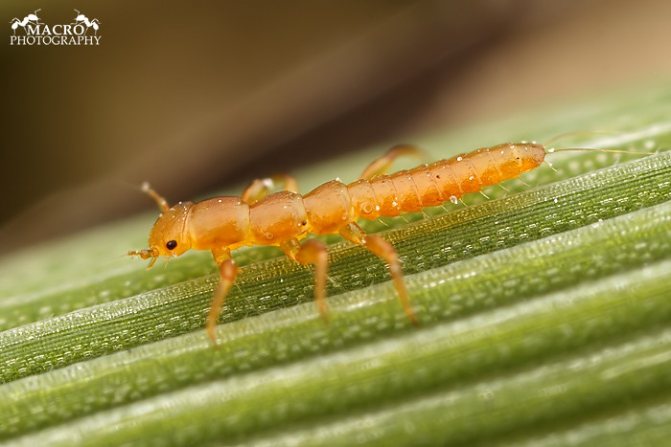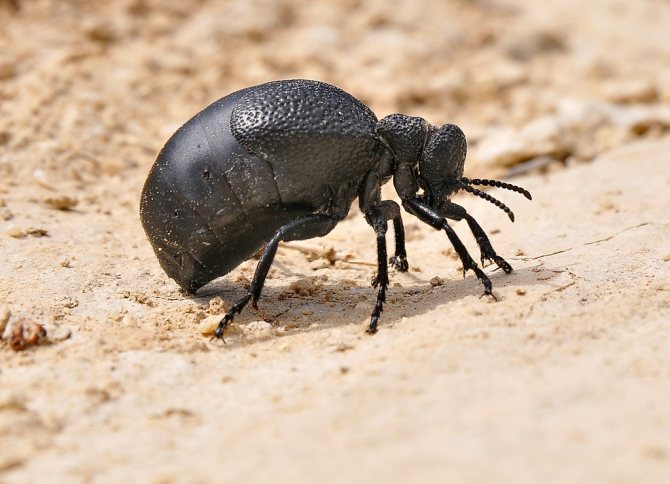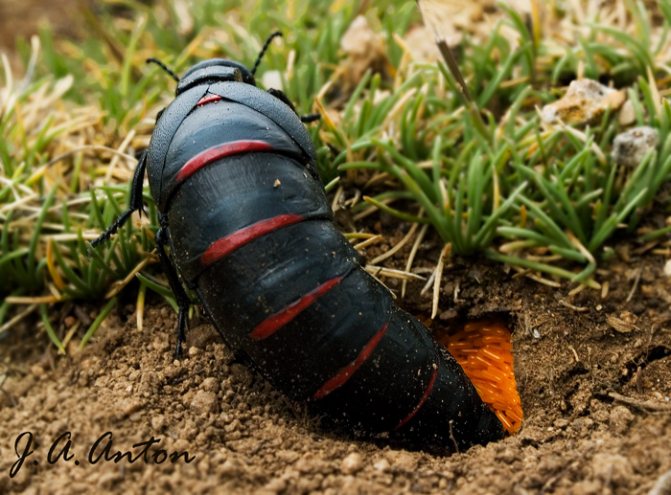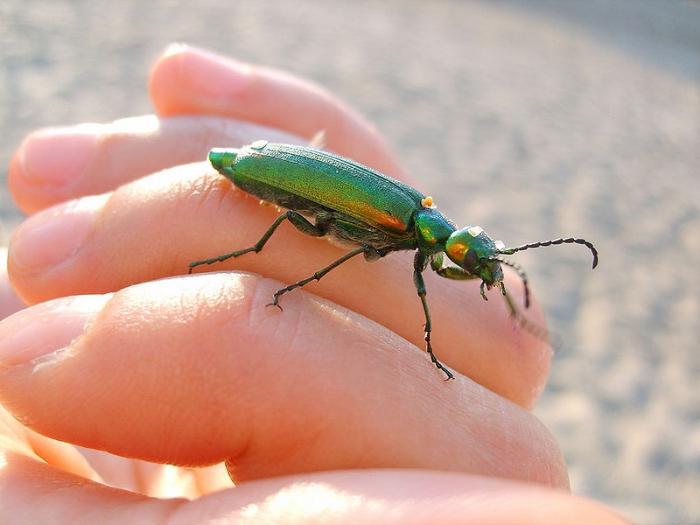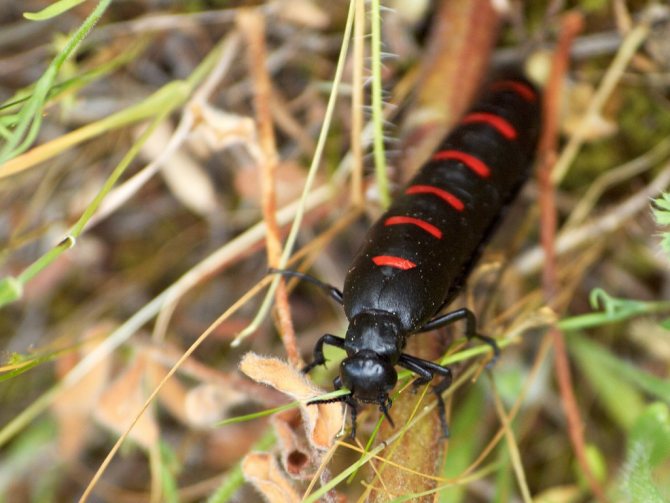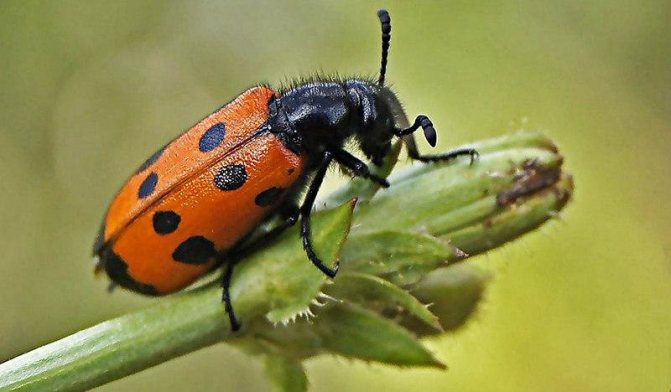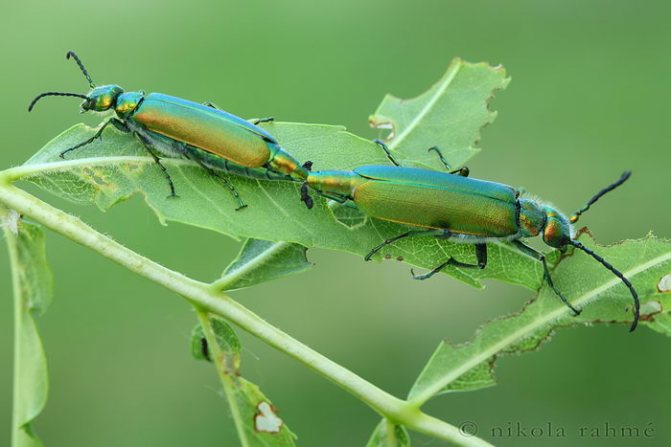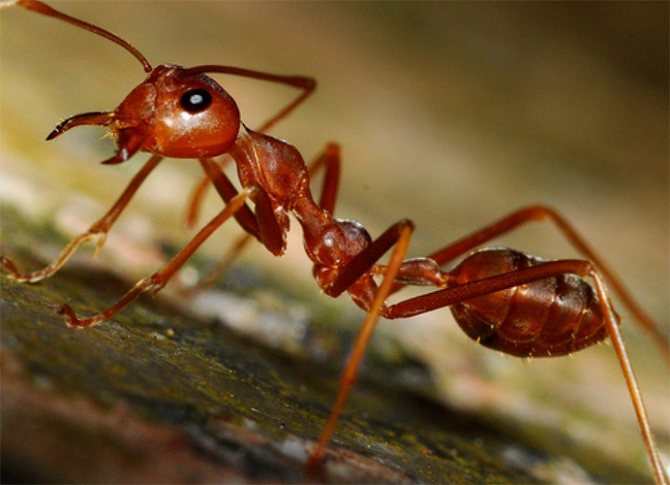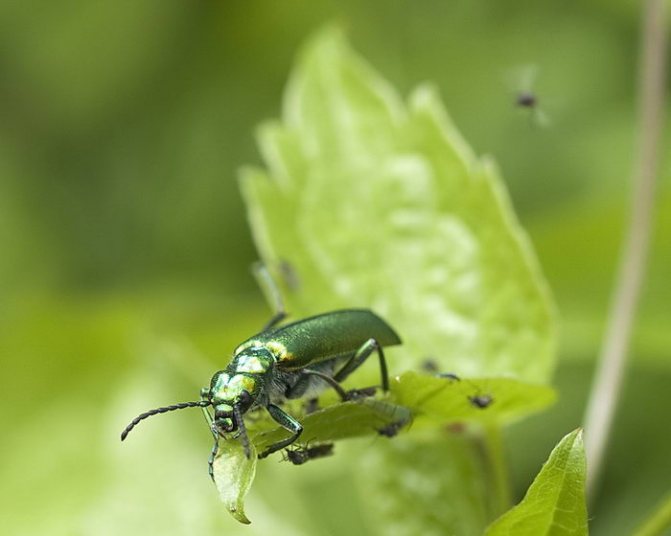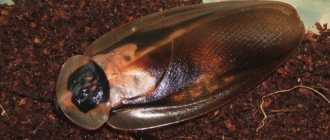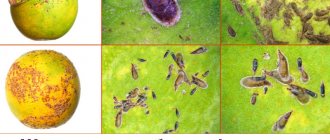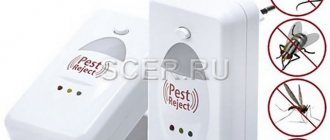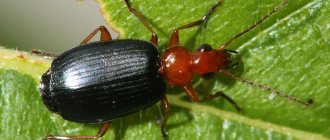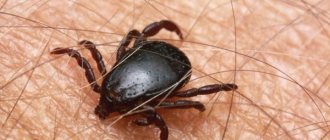Description of appearance
Externally, blister beetles are similar to each other, the colors are different. The body is elongated, long, thick - up to 2 cm. In some species it drags along the ground. The wings are absent, the elytra are short, covering only a small part of the chest. The head is small, lowered to the bottom. There are long, straight antennae on the head. Photo of blister beetles is posted below.
Interesting!
Different species differ in color, body length, shape. For some of them, it resembles a keg. The female holds up to 10,000 eggs. The color is dark with bright stripes or monochromatic.
Blind
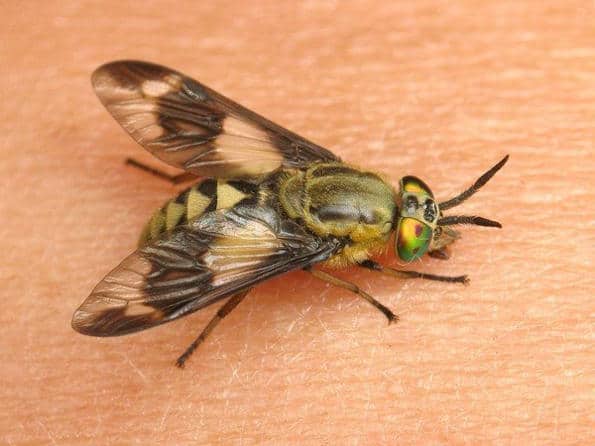
These insects are often encountered by people who keep pets in the country. Horseflies bite very painfully. At the site of the bite, swelling and compaction occurs, the affected area becomes hot. In particularly sensitive people, the body temperature may rise.
Horseflies are carriers of dangerous diseases, which include:
- Tularemia;
- Anthrax;
- Filariasis.
In people prone to allergies, horsefly bites cause a strong reaction. In this case, you need to urgently consult a doctor.
To reduce pain, the wound is washed with vodka or hydrogen peroxide, and then ice is applied. The victim is given an antihistamine.
Lifestyle
Blister beetles are parasites. The main purpose of the imago is procreation. After fertilization, up to 10 thousand eggs develop in the female's body. She lays them in the soil, closer to the place where potential victims live. Often they are bees, locusts.
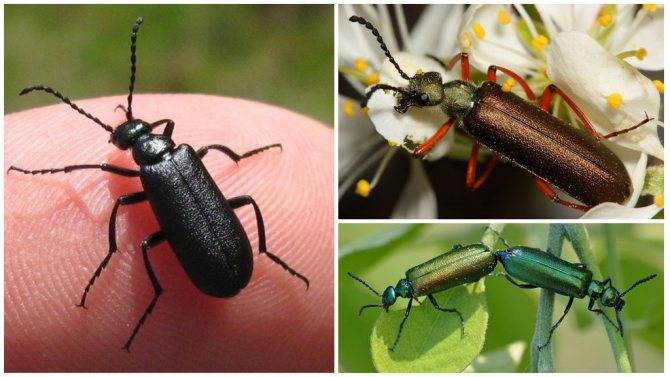

Blister beetles
A few weeks later, amber-yellow larvae with three pairs of limbs - triungulins appear from the eggs. They feed on insect larvae, finding their locations thanks to their sensitive sense of smell.
Bees very often become victims of larvae. Triungulins make their way into the hive in several ways:
- They climb into the flower, wait for the landing of the bee, imperceptibly cling to its body, fly into the nest.
- They cling to several pieces, forming a living ball. Pheromones are released, similar to those released by the female bee. The male flies up to the ball, grabs it, drags it with him into the hive.
Inside, the larvae of blister beetles eat nectar, honey reserves, and bee larvae.
Triungulins molt several times, increase in size, pupate at the end of the development cycle. A few weeks later, an adult is born.
Order Retinoptera
Retinoptera are a relatively small, fully transformed order of insects. It has about 5 thousand species. They got their name for their mesh wings. Indeed, two pairs of wings of these insects are covered with a very dense network of veins. The coloration of retinoptera is, as a rule, modest - pale green or brown. Although, sometimes it is bright (Fig. 74, 75).
Fig. 74. Askalaf
Fig. 75. Nymphida
Interestingly, sometimes retina-winged animals have bright golden eyes, like the well-known lacewings (Fig. 76).
Fig. 76. Lacewing
The order Retinoptera includes insects such as lacewing, ant lions (Fig. 77) and interesting insects mantisps (Fig. 78).
Fig. 77. Ant Lion
Fig. 78. Mantispa
Retinoptera are usually carnivores.In most cases, these are small insects ranging in length from several to several tens of millimeters. However, among ant lions, there are also very large ones.
Fig. 79. Threadwing
The mouth apparatus of the adult is gnawing. The mouth apparatus of the retina wing larvae is interesting. Their jaws grow together in pairs, forming, as it were, two hollow sharp tubes. Such a mouth apparatus works like a piercing-sucking apparatus. The larva pierces its prey with its jaws and injects digestive juice into its body, and then sucks out the liquefied contents of the victim with the same jaws. Thus, the digestion of retina wing larvae is external. Interestingly, in these larvae, undigested food debris is not thrown away, but accumulates inside the body. The excrement is thrown out only when the imago leaves the pupa. Probably the most famous retina wing is the common lacewing. These insects are predominantly nocturnal predators. It is not difficult to find them in the garden or at the edge of the forest. The animals are small, the body length is about 1 cm.
Their small eggs on a graceful leg can be found next to aphid colonies (Fig. 80).
Fig. 80. Lacewing Eggs
The larva emerging from the egg immediately begins feeding. She still eats the same aphids (Fig. 81).
Fig. 81. Lacewing Larva
The larvae of lacewings pupate in a spider's cocoon, and it is interesting that they secrete silk not with the help of glands on the lower lip, like many other insects with complete transformation, but with the help of malpighian vessels (Fig. 82).
Fig. 82. The emergence of adults from the cocoon
Predatory ant lion larvae live in dry sand. Moreover, the larva digs a trapping funnel. The insect itself is located at its bottom, exposing its jaws outward. When a small prey insect enters the funnel, the ant lion larva, using the folded jaws together like a shovel, begins to throw sand at the victim. The sand, as it were, knocks a small insect to the bottom of the funnel. When the victim is at the bottom of the funnel, the ant lion pierces it with its jaws and eats it.
Benefit and harm
Adult males, females feed on the green part of plants, do not bring much harm with their vital activity. The larvae are parasites. Some species are beneficial - they reduce the number of locusts and other pests of agricultural crops. Others cause damage by destroying bee colonies.
You can meet the pest on any plant, since these creatures are omnivorous. They lead a daytime lifestyle. They gnaw on leaves, shoots, flowers. Legumes, potatoes, mustard, turnips, and grain crops are destroyed in the gardens.
Interesting!
In the past, medical preparations - diuretics - were prepared from blister beetles to increase potency. Canceled due to side effects. The funds negatively affected the functioning of the liver, kidneys, and the nervous system.
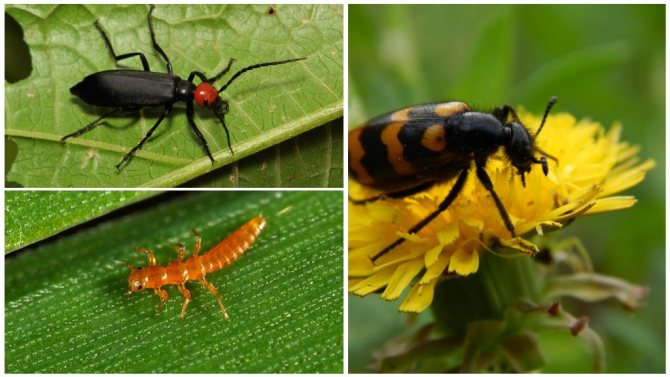

Blister beetle
The bites of the bladder beetle are not dangerous to humans, and the substance that the insect secretes, sensing danger, is poisonous. A burn, blister or abscess instantly appears on the skin. Requires special treatment of the bite with the use of local antiallergic, antihistamines, anti-inflammatory drugs.
Dangerous meeting with blister beetles for cats and dogs. If swallowed, intoxication develops. Kittens, puppies die without qualified help.
What dangerous insects can be found in Russia.
Good day, kamarada!
I continue here with an overview of small creatures, but dangerous to human health ... Of course, some of them are practically not found in the vastness of our Motherland ... But the climate is warming. And the population of some species begins to migrate to the north, which means that we have an increased chance of meeting yesterday's "exotic" in the nearest grove.And one should not forget about possible "stuffing" by the special services, as well as about the banal laxity of those who must determine what and how much should be placed in the quarantine zone of the customs and what is generally allowed to be imported into Russia (about the dead boxwood in Sochi, I hope, all remember?) Therefore, adhering to the principle: "He who is forewarned is armed", let's start ...
1. Ticks.
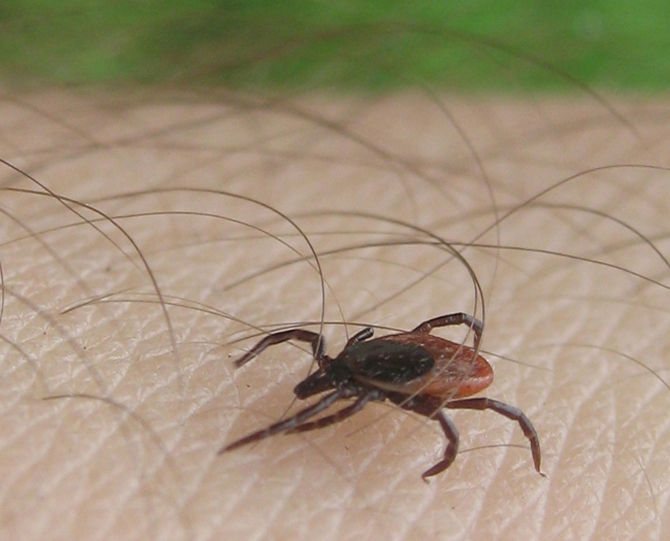

These are the most numerous representatives of the arachnid class. At the moment, there are about 48 thousand different types of them. But not all of them are dangerous, and more than half are not found not only in Russia, but also in the neighboring countries. It is believed that only about 10% of ticks carry dangerous diseases. Among them are the encephalitis tick, the taiga tick - these are the inhabitants of Russia ... (articles on them were published here earlier, I will add links later)
At first, the tick bite is completely invisible and does not cause any inconvenience. But within two to three days after the bite, the area of the body in which the tick that bit you is located begins to redden and swell. In order to avoid serious consequences, it is necessary to examine the body after a hike in nature, use appropriate equipment and repellent sprays (Taiga, Mosquito against ticks, etc.), and also immediately consult a doctor and in no case try to remove the tick yourself (unless you have a special device or skills).
The worst of the consequences of an encephalitis tick bite is the possibility of joint damage and subsequent disability.
The period of their activity is from May to September (taking into account the apparent warming).
2 horsefly.
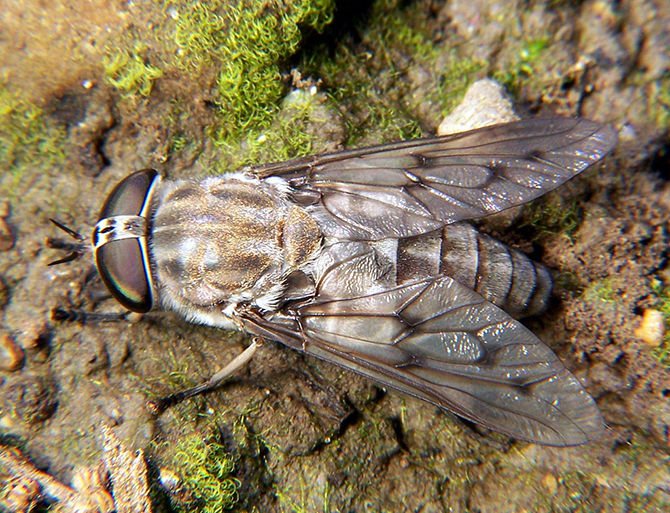

Horsefly is a dangerous species of insects, on the territory of Russia its population is large and this creature is found everywhere. The period of their activity falls on the summer, and neither heat nor rain can stop them. They live mainly in forests and steppes. They are most active during the daytime, especially in hot, sunny weather. But only the female horsefly is dangerous, she bites a person and cattle and drinks blood. In Russia, you can find about 200 species of horseflies.
Blind blood is needed for nutrition and for the formation of a substance necessary for reproduction. Horsefly can carry dangerous diseases, including anthrax and polio. Also, a wound that is obtained as a result of a horsefly bite can fester and become inflamed, which also threatens human health. During the bite, the horsefly injects a special substance into the human body, which includes anticoagulants. They cause severe skin irritation and can impair blood clotting. In some people, a horsefly bite can trigger an allergic reaction, the effects of which can range from swelling to fainting.
3. Bubble beetle.
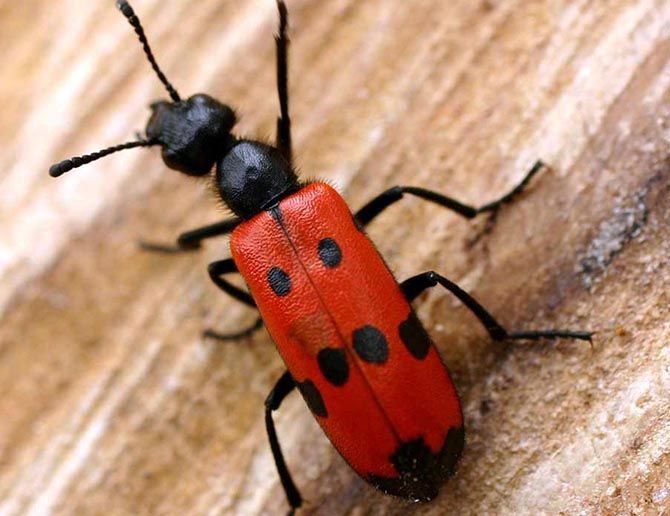

The blister beetle is an extremely dangerous poisonous insect that lives in the regions of Central Asia, the Caucasus and Kazakhstan. About 70 different species of this insect are known. In appearance, this beetle is not at all scary and looks like a ladybug with a slightly elongated body. They live in hot regions, mainly in forest areas, they can even harm plants and shrubs. Until recently, it was not found in Russia except in the regions of the Caucasus region, but in 2020 it was discovered in the Astrakhan region.
The danger of this little beetle lies in the composition of its poison - it contains the substance cantharidin. It is a very dangerous and caustic substance that was previously even used for medicinal purposes, like bee venom. But in medicines it was used in very small doses.
When the poison of the blister beetle gets on the skin, the site of the lesion becomes highly inflamed, turning into abscesses and blisters. If poison gets into wounds, it can affect the functioning of the urinary tract and kidneys. A. if the poison enters the bloodstream, it can lead to death. In the Middle Ages, some kings were sent in concentrated blister beetle venom and died in agony.
In order to exclude poisoning, you must completely protect yourself from any contact with this insect.
4. Karakurt.
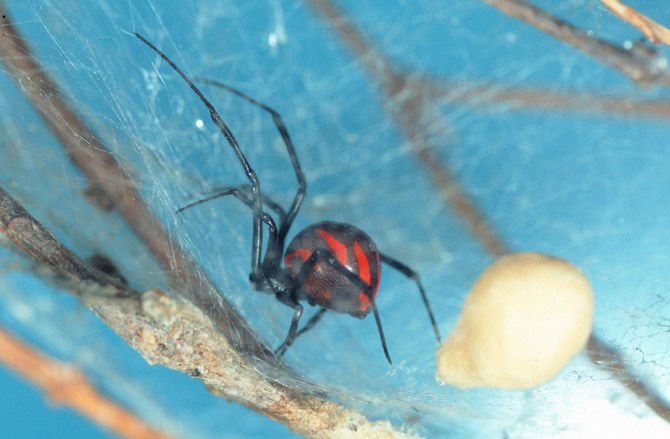

Karakurt is a poisonous spider that lives in the southern regions of the world. In Russia, its habitat is in the steppes of the Astrakhan region. However, recently this species was found in the territories of the Saratov and Volgograd regions.
The male of this insect is harmless, the female karakurt is a danger to humans and some species of animals. Her bites can be fatal for a horse, a camel, and a person. However, the spider does not attack without reason, he attacks the enemy only if he believes that he is in danger.
The poison of the female karakurt is very strong and is second only to the venom of the black widow spider, but it is contained in the blood of a bitten individual much longer. The main period of activity of the karakut falls on June - July, since it is during this period that the female spider migrates. Sometimes they can migrate to the northern regions, including the Moscow region. A spider bite usually immediately causes severe, burning pain, and the venom spreads throughout the body within half an hour. Usually, the bite of a female karakurt leads to clouding of consciousness, delirium. There are cases in which, without timely medical care, a spider bite caused death. At present, insect poisoning is being carried out in the habitats of the karakurt in order to protect the people and livestock living in the area.
5. Hornets.
If earlier it was worth fearing the common hornet Vespa Crabro, now in Russia there is also its larger brother - the Asian giant hornet.
Common hornet - this is a large (the length of its body reaches 3.5 cm) insect, similar in color to a wasp. The hornet's mother is usually larger (it can be seen in May-June, looking for a place for a nest).
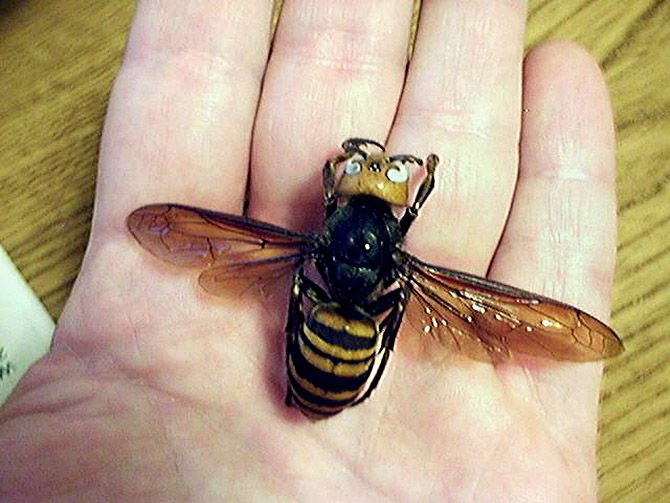

Like ordinary wasps, hornets do not leave a sting in the body of the victim. When a hornet stings, a burning pain appears at the site of the bite, the site of the bite swells greatly. According to the testimony of the "lucky ones" who have experienced the sting of a hornet, the bite feels like "as if they hit the leg with a stick" or "as if a red-hot nail was stuck" ... In addition to pain, in some cases breathing problems may occur, the face may turn pale, the pulse becomes more frequent, loss of consciousness is possible. In such cases, you must immediately call an ambulance or take the victim to the hospital.
There is a misconception that 3 hornet bites kill a person, and seven - a horse. This is, of course, an exaggeration. However, these insects should not be underestimated. If you stumble upon a hornet's nest in the forest or at your site, then for your own safety, it is not recommended to approach it closer than 5 meters. And if you are alarmed, then it is advisable to quickly retire to a distance exceeding 20 meters, since the hornets CONSTANTLY patrol the area around the nest (if it is in a hollow, and not in your attic, of course), and in case of an "invasion" they begin an active search for the "intruder", attacking even fellows! (I destroyed several nests and observed the consequences personally - it was interesting, considering that I was dressed in such a way that the possibility of a hornet bite was completely excluded).
If the hornets have established their housing in your country house, garage or on a plot, then, in principle, it is better to turn to specialists to destroy these dangerous "neighbors" ....
Asian giant hornet - This is a very rare insect for Russia, which poses a significant danger to humans. It is mainly found in Asian countries such as China and Japan. In Russia, the Asian hornet is found in the Primorsky region. For its size and color in China, it is even called the tiger bee.
Its dimensions are really large: the hornet reaches more than 5 centimeters in length (the uterus is even larger), and its wingspan is more than 8.5 centimeters.This insect also has a long sting that can be 6-7 millimeters long.


The poison of the Asian giant hornet is extremely toxic and dangerous to humans. This poison contains the substance mandorotoxin, which causes severe pain and allergic reactions. People who are allergic to bee and wasp stings, when bitten by an Asian hornet, are most likely doomed to death.
6. Wasps and bees.
Wasps are found everywhere in Russia. In rural areas, in utility blocks and attics, you can shoot their nests under the roof, ranging in size from a "ping-pong ball" to a "basketball". The number of individuals in the nest can be inferred from its size. In large nests, their number may exceed 100.
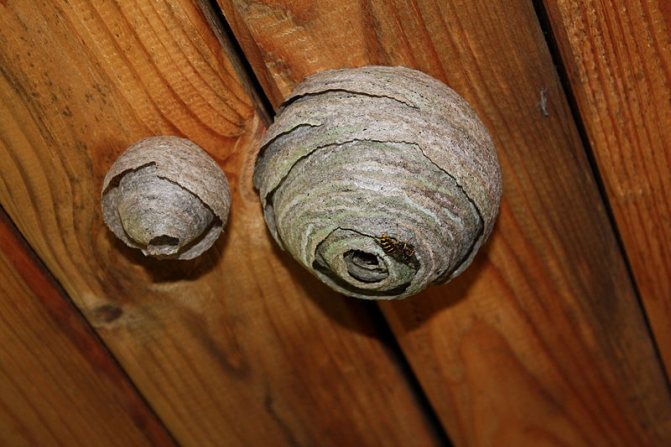

Despite the incredible pain, wasp stings are not dangerous for this reason. Although the main goal of the insect itself during defense is precisely to inflict pain on a potential enemy to scare him away, the threat to human health is determined primarily by the possibility of developing an allergic reaction to the toxins contained in the poison.
Wasp venom is a powerful allergen that causes extensive local edema in most people. However, if a wasp sting happens in a person who is especially sensitive to toxins of insects, then the likelihood of developing much more serious allergic reactions will be quite high.
But the harm to human health is not limited to this, kamarady! Additional consequences of a wasp sting are also possible, namely:
- an increase in blood sugar levels, which is very dangerous for those suffering from diabetes mellitus;
- increased cardiac output;
- lowering blood pressure;
- increased breathing.
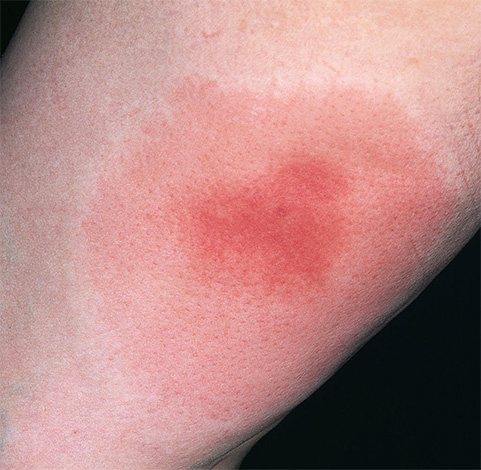

Bees ... Almost every one of us has been bitten by a bee at least once, so we know from our own experience how painful it is. As a rule, such an unpleasant event does not require medical attention, unless you have an allergy. If there is no tendency to unexpected reactions to bee or wasp stings, then there is nothing to worry about. But in the presence of allergies, serious problems are possible: the poison causes anaphylactic shock, which manifests itself in hives, difficulty breathing, confusion and paleness. The extreme stage is loss of consciousness, and even death. Dangerous toxic reactions from bites in the head, blood vessel and mouth. A swallowed bee can cause swelling of the pharynx and death by suffocation. It is useful to know that when a bee stings, you should not kill it immediately. Firstly, it will die without a sting (unlike a wasp, which can sting several times), and secondly, a killed bee will release a special chemical into the air, which will be an alarm signal for its other relatives.
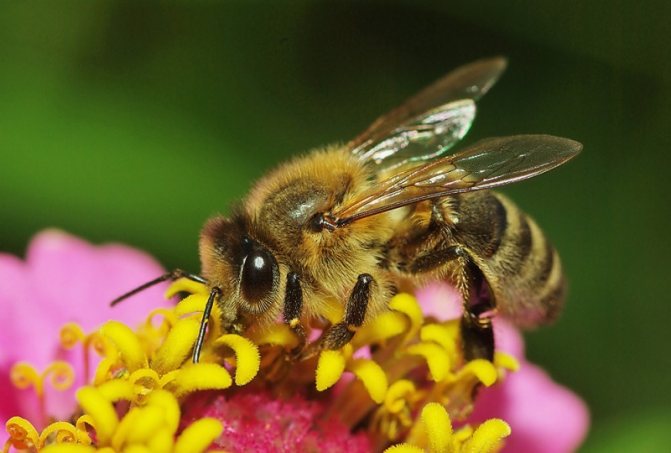

How to deal with a pest
There is no clear single mechanism. Pests are widespread throughout the warm season. Experts propose to fight the blister beetle with biological, agrotechnical, folk methods.
- Ash is sprayed on the site, ash and tobacco dust are scattered. Means scare off adults.
- Dig up the soil in autumn, spring. This will help kill the larvae.
- Natural enemies of blister beetles are hedgehogs. The poison of insects does not work on these animals. If you settle a hedgehog in your area, you can also get rid of rodents.
It is advisable to use chemicals if blister larvae are seen on the plants. It is forbidden to use insecticides during flowering.
Control methods
Nibs help control locust and Italian locust populations. Usually, the benefits of insects outweigh the potential harm. But in large quantities, the red-headed blister poses a danger to vegetable gardens and fields. Agrotechnical methods are used to combat it:
- autumn plowing;
- weed control.
On the backyard, the spanks are manually collected and destroyed. The work is carried out in the early morning, always wearing gloves that protect the skin.In some cases, plants have to be treated with insecticides.
Natural enemies are not a hindrance
The consequence of the appearance of beetles in fish farms or artificial reservoirs can be the extermination of a large number of fish. However, there are also such creatures who eat the swimming beetle in the reservoir with great pleasure - these are various invertebrates, large fish, birds and mammals.
The larvae of diving beetles also have enemies. We are talking about an aquatic parasitic insect - a parasite, which has the strange name of predominance. Having found an egg of a diving beetle, the female rider lays her eggs in it.
The small size and remarkable appearance should have made the diving beetle an easy prey for large predators, but the beetle is not afraid of anyone, it is armed with chemical weapons. There are glands on the beetle's breast that secrete a cloudy, toxic liquid that makes anyone spit it out immediately.
Marriage "games"
Once in the water, the swimmers begin to hunt, this time for the female. Seeing a lady, the gentleman will not waste time on courtship and other romance. He grabs her with his front paws and immediately gets down to business.
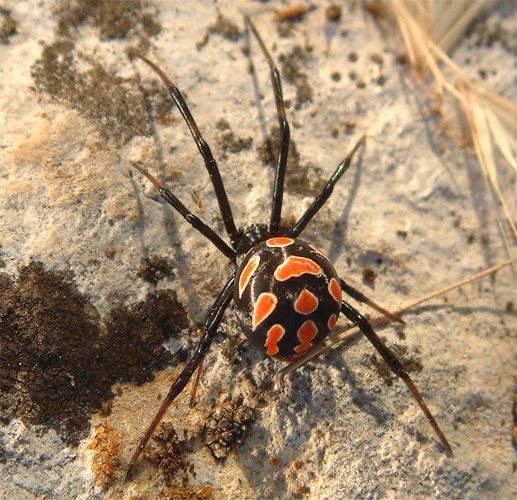

In this case, the male is on top of the female and only he can put his abdomen on the surface to replenish oxygen reserves. The female has to be content with reserves under the elytra. And if only one suitor covets her, then everything will be in order, but if several males in a row, which happens at the beginning of the mating season, most likely she will die of suffocation.
Difficult period
For the winter, swimmers hibernate. Immediately after awakening, their mating season begins. After leaving the underground bedroom, the beetle rises into the air and flies in search of a suitable reservoir. In flight, he focuses on his vision, which sometimes fails, and the beetle flops on wet asphalt or an iron roof.
We suggest that you familiarize yourself with How to remove a slime from clothes
It can also descend a few centimeters or meters from the reservoir, and then the rest of the journey has to be done on foot. On land, the diving beetle moves very awkwardly, but quickly enough.

